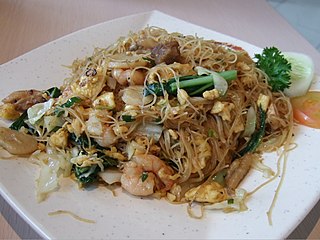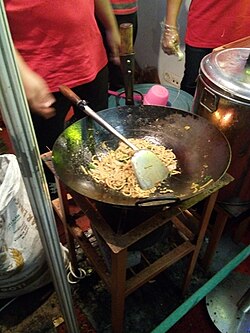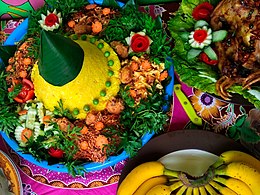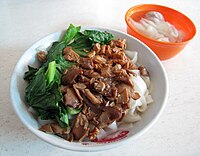
Laksa is a spicy noodle dish popular in Southeast Asia. Laksa consists of various types of noodles, most commonly thick rice noodles, with toppings such as chicken, prawns or fish. Most variations of laksa are prepared with a rich and spicy coconut curry soup or a broth seasoned with asam.

Malay cuisine is the traditional food of the ethnic Malays of Southeast Asia, residing in modern-day Malaysia, Indonesia, Singapore, Brunei, Southern Thailand and the Philippines as well as Cocos Islands, Christmas Island, Sri Lanka and South Africa.

Noodle soup refers to a variety of soups with noodles and other ingredients served in a light broth. Noodle soup is a common dish across East Asia, Southeast Asia and the Himalayan states of South Asia. Various types of noodles are used, such as rice noodles, wheat noodles and egg noodles.

Chinese Indonesian cuisine is characterized by the mixture of Chinese with local Indonesian style. Chinese Indonesians, mostly descendant of Han ethnic Hokkien and Hakka speakers, brought their legacy of Chinese cuisine, and modified some of the dishes with the addition of Indonesian ingredients, such as kecap manis, palm sugar, peanut sauce, chili, santan and local spices to form a hybrid Chinese-Indonesian cuisine. Some of the dishes and cakes share the same style as in Malaysia and Singapore, known as Nyonya cuisine by the Peranakan.

Rice vermicelli is a thin form of noodle. It is sometimes referred to as "rice noodles" or "rice sticks", but should not be confused with cellophane noodles, a different Asian type of vermicelli made from mung bean starch or rice starch rather than rice grains themselves.

Fried noodles are common throughout East Asia, Southeast Asia and South Asia. Many varieties, cooking styles, and ingredients exist.

Bakmi or bami is a type of wheat based noodles derived from Chinese cooking tradition. It was brought to Indonesia by Chinese immigrants from Southern Chinese provinces like Fujian. It is typically prepared seasoned in soy sauce and topped with pork products, which is often substituted for other protein sources in predominantly Muslim Indonesia. Chinese-style wheat noodles has become one of the most common noodle dishes, especially in Southeast Asian countries which have significant Chinese populations and known by various names.

Mie goreng, also known as bakmi goreng, is an Indonesian stir-fried noodle dish. It is made with thin yellow noodles stir-fried in cooking oil with garlic, onion or shallots, fried prawn, chicken, beef, or sliced bakso (meatballs), chili, Chinese cabbage, cabbages, tomatoes, egg, and other vegetables. Ubiquitous in Indonesia, it is sold by food vendors from street hawkers (warungs) to high-end restaurants.

Javanese cuisine is the cuisine of Javanese people, a major ethnic group in Indonesia, more precisely the province of Central Java, Yogyakarta and East Java.

Soto mie, Soto mi, or Mee soto is a spicy Indonesian noodle soup dish commonly found in Indonesia, Malaysia, and Singapore. Mie means noodle made of flour, salt and egg, while soto refers to Indonesian soup. In Indonesia, it is called soto mie and is considered one variant of soto, while in Malaysia and Singapore it is called mee soto.

Kwetiau goreng is an Indonesian style of stir fried flat rice noodle dish. It is made from noodles, locally known as kwetiau, which are stir-fried in cooking oil with garlic, onion or shallots, beef, chicken, fried prawn, crab or sliced bakso (meatballs), chili, Chinese cabbage, cabbages, tomatoes, egg, and other vegetables with an ample amount of kecap manis. In Asia, kwetiau is available in two forms, dried and fresh. Its recipe is quite similar to another Chinese Indonesian favourite, mie goreng, with the exception of replacing yellow wheat noodles for flat rice noodles.

Mie ayam, mi ayam, or bakmi ayam is a common Indonesian dish of seasoned yellow wheat noodles topped with diced chicken meat. It is derived from culinary techniques employed in Chinese cuisine. In Indonesia, the dish is recognized as a popular Chinese Indonesian dish, served from simple travelling vendor carts frequenting residential areas, humble street-side warung to restaurants.

Mie koclok, is an Indonesian chicken noodle soup, a specialty of Cirebon city, West Java. The noodles come with a white-colored extra-thick porridge-like soup, made of chicken broth and coconut milk soup, which is coagulated with corn starch or tapioca. Other ingredients include shredded chicken breast, cabbage, bean sprouts, hard boiled egg, kaffir lime juice, and sprinkled with sliced fresh celery, spring onion, and fried shallot.

Betawi cuisine is rich, diverse and eclectic, in part because the Betawi people that create them were composed from numbers of regional immigrants that came from various places in the Indonesian archipelago, as well as Chinese, Indian, Arab, and European traders, visitors and immigrants that were attracted to the port city of Batavia since centuries ago.

Soto is a traditional Indonesian soup mainly composed of broth, meat, and vegetables. Many traditional soups are called soto, whereas foreign and Western influenced soups are called sop.

Kwetiau ayam, kuetiau ayam or sometimes kwetiau ayam kuah is a common Chinese Indonesian dish of seasoned flat rice noodles topped with diced chicken meat. It is often described as a kwetiau version of the popular mie ayam, and especially common in Indonesia, and can trace its origin to Chinese cuisine.

Mie bakso is an Indonesian noodle soup dish consists of bakso meatballs served with yellow noodles and rice vermicelli. This dish is well known in Chinese Indonesian, Javanese and Malay cuisine. Mie bakso is almost identical with soto mie, only this dish has meatball instead of slices of chicken meat.

Bihun goreng, bee hoon goreng or mee hoon goreng refers to a dish of fried noodles cooked with rice vermicelli in both the Indonesian and Malay languages. In certain countries, such as Singapore, the term goreng is occasionally substituted with its English equivalent for the name of the dish.

































